Best Pedometers Reviewed and Rated
Disclosure: We use affiliate links and may receive a small commission on purchases.
Having a pedometer opens opportunities for physical exercise that you did not possibly think about. How many times have you wished that you would know the number of steps, calories that you burn, or distance that you cover in your daily walk, jog, run, or even just walking throughout the day? Other times you would like to make and review your fitness goals, but you do not have a means to. You may want to increase your walking pace but wonder how to tell whether you are walking faster accurately. Well, a pedometer answers all that.
Quality and quantity of exercise are crucial to meeting your fitness goals. It is then, of essence to have a method that objectively measures the quality and amount of your physical activities. You can then use that information to set goals, monitor progress and review your goals. Let’s take for instance that you have been walking in your neighborhood for that last five years- same route, same distance, and same pace. Yet, you no longer lose any weight or get physically fitter. You can benefit more from your walk by increasing your steps, speed or distance. A pedometer will help you monitor all that.
Our Top 3 Picks
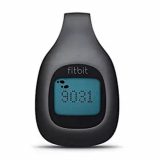
- Fitbit Zip
-
Our rating - Light
- Price: See Here

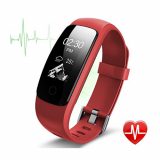
- Lintelek
-
Our rating - Comfortable
- Price: See Here

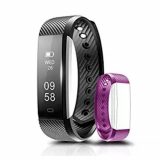
- Coffea Fitness
-
Our rating - Waterproof
- Price: See Here

So, what is a pedometer? A pedometer is a portable electric device that counts your steps by detecting movement of the pelvic bone or hands. A pedometer can also record the number of calories that you have burnt, the distance that you covered, duration of your walk, and your walking speed per hour.
Some brands have advanced so much that in addition to counting your steps, they also track your sleep quality and duration and your heart rate. There are others that can synchronize with your phone or computer. Hence, you can connect with other users to share goals, motivation, and achievements.
We reviewed pedometers available in the market and picked the best that are reliable and consistent.
10 Best Pedometers
1. Fitbit Zip
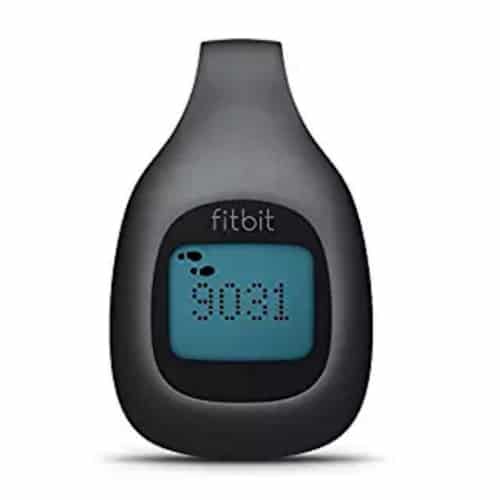
Tracks steps, distance, calories, and time of your activities all day long
Has wireless and automatic synchronization with your Android phone, tablet, iPhone, or Windows phone
Is wear and water resistant
Battery life is up to eight months
Comes with a Fitbit application for smart phones
Recommendation for usage: Wear it on your waist or put it in your pocket.
Price/Value
Although Fitbit Zip is pricey, the price is justified by its features. This pedometer is superior to others as it synchronizes with more devices and tracks your progress for a long time.
Verdict
This is an excellent product that you can use comprehensively to maintain and improve your physical fitness. The product also gives you access to nutrition monitoring through its Fitbit application. It is also a good product if you like working with others to up your motivation, set goals together and share your achievements.
- Compatible with computer, tablet, windows, android and iPhones
- Water and wear resistant
- Can track progress for more than one month
- Access to nutrition information on Fitbit application
- Is small and light
Battery life is only eight months
2. Lintelek
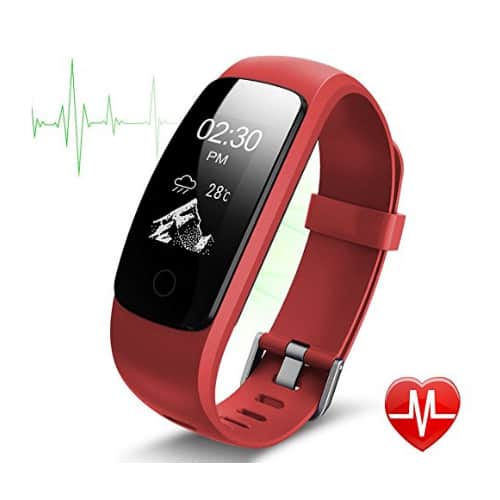
Lintelek can be used to monitor over fourteen activities such as walking, trekking, hiking, yoga, dancing, badminton, treadmill, spinning, cycling, tennis, etc. This product also connects to GPS using your smart phone, hence tracks real time routes. It is waterproof and has an inbuilt weather forecast system that helps you plan your activities ahead of time. It also tracks your sleep duration and consistency and has guided breathing sessions suitable for yoga and meditation.
Application: Uses Very Fit Pro application from Google store or Apple
Screen: 0.96” OLED Touch Screen
Waterproof Rating: IP67 sweat and rain proof
Operating system Android 4.4 or above, IOS 7.1 or above version
Charge time: 1 hour
Working Time: 5 to 7 days
USB- Inbuilt
Recommendation for usage: Wear on the wrist or waist and charge 10 minutes before use.
Price/value
This product may look a bit pricey compared to other products, but for these features and specifications, it is the most affordable.
Verdict
Lintelek Smart pedometer is a good buy if you want to monitor not only your steps but also your heart rate and sleep. It is an excellent planner for your physical activities as it has a weather forecast feature and you can log in your goals and review them goals on your smartphone.
- Compatible with both Android and IOS phones
- Fashionable and comfortable
- Sweat and rain proof
- Can control music from your phone
- Can be used for multiple sports not just walking
- Tracks real time routes using GPS
- Alerts when you are inactive
- Keeps charge for long
- Not recommended for swimming or showering
- Not compatible with a personal computer, iPad or Tablet
3. Coffea
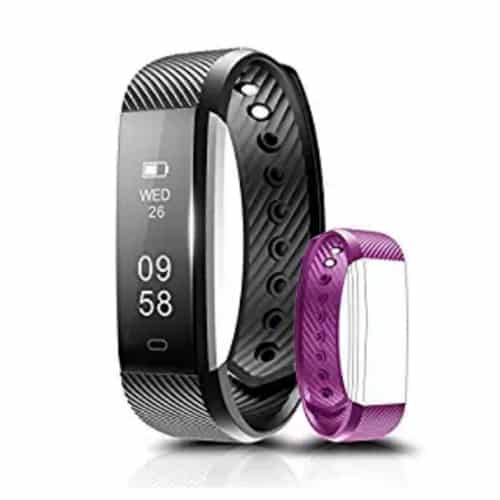
Counts steps, distance covered and calories burned
Monitors sleep duration and motions during your sleep
Is sweat and rain proof, and can be used while swimming for up to thirty minutes
Inbuilt USB port, can be charged with your personal computer or smartphone charger
Compatible with IOS 7.1, Android 4.4 and Bluetooth 4.4
Battery charging time is 45 minutes and standby time seven days
Recommendation for use: Wear on your wrist.
Price/Value
This product comes at an excellent, affordable price considering that is waterproof, durable, compatible with a phone, and tracks sleep duration.
Verdict
If you want a pedometer that not only tracks your steps but is also compatible with your smart phone and you can even go for swimming with, then Coffea is a good option. The only shortcoming is that it does not monitor your heart rate.
- Waterproof and can be used when swimming for up to 30 minutes
- Multifunction of counting steps, calories, distance covered, and sleep duration and quality
- Slim, comfortable and fashionable
- Compatible with both android and apple phones
- Not suitable for people sensitive to rubber as the wristband is made of rubber
- No heart rate monitor
4. Icefox
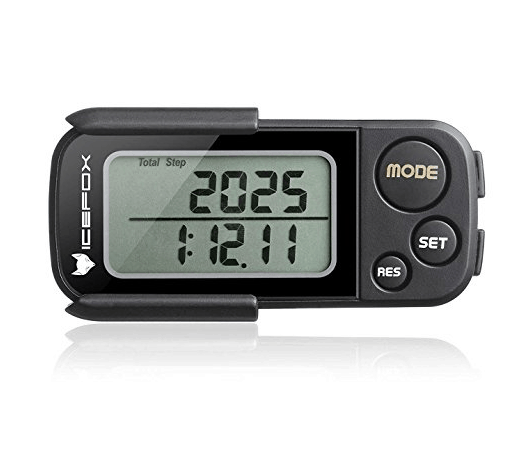
Records daily steps (running and walking), distance, the time taken, and calories burned
Uses Tri-Axis 3D sensor technology
Has a display memory of up to 30 days
Recommendation for use: Comes with a strap and clip hence, can be worn on the wrist, leg, thigh, or put in the pocket or purse
Price/Value
Icefox is a bit pricey considering that you can only use it for walking or jogging.
Verdict
This is an excellent buy if you want to capitalize on walking or jogging. You can set daily goals and review your progress for the past thirty days. We highly recommend if you are monitoring weight loss goals or aiming to improve your fitness goals by simply walking or jogging.
- Can be worn on the wrist, waist, leg, thick or put in the pocket
- Has a large display of figures
- Multifunction of tracking steps, distance, time and calories
- You can check progress for the last one month
- You can set daily goals
- Only tracks steps while walking or jogging
5. ARCHEER
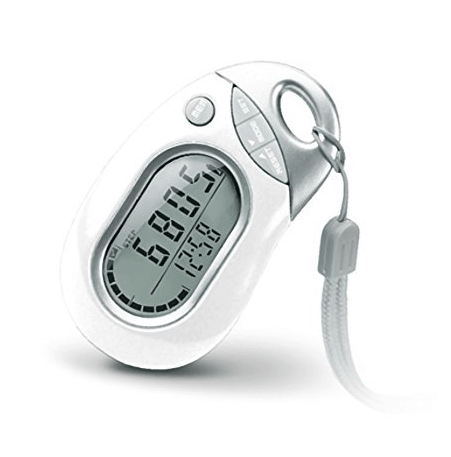
Uses 3D Tri-Axis Technology
Calculates steps up to 99,999
Calculates calories, distance, and speed
Keeps data for up to 7 days
Allows goal setting
Has a digital clock function
Large display
Low battery indicator
Recommendation for use: Can be put in the pocket or purse.
Price/Value
A little bit pricier in comparison to other pedometers on this list. However, very accurate and reliable therefore worth the price.
Verdict
With Archeer you can set goals on increasing distance, calories and your pace. You can then review these goals weekly.
Uses 3D sensor technology
Large display
Memory of up to 7 day
Multifunction to monitor steps, distance, speed and calories
Small size suitable for the pocket
A bit challenging to set
6. CSX P375
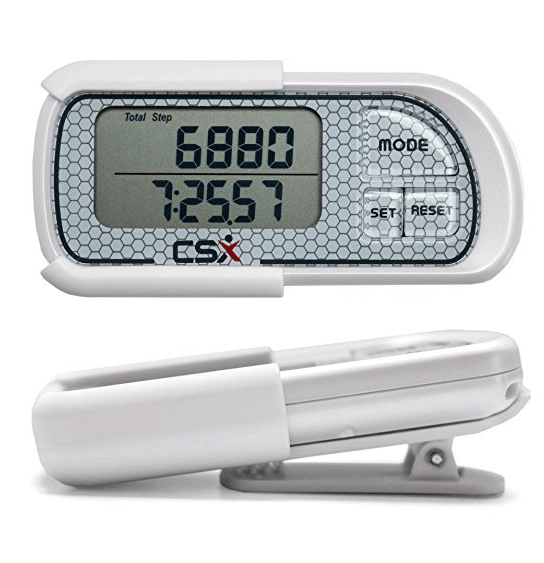
Uses 3D Tri-Axis Sensor
Monitors steps made, distance covered (in miles and kilometers), calories burned, and time taken
Has a 30-day memory
Comes with access to a downloadable PDF book titled, “Walk Yourself Fitter.”
Has a buffer step that filters false steps
Has a large display screen
Clock is in 12 or 24-hour format
Recommendation for use: You can wear it on the waist, neck or put it in your pocket or purse.
Price/Value
Though a bit pricey for these features, CSX pedometer is worth if you want more than just counting your steps. It is accurate, has a reasonable large display of figures, so you do not have to struggle looking at your results.
Verdict
CSX pedometer is suitable for you if you want an accurate pedometer that filters out false steps and one that you can put in your pocket or around the neck. You can also use the product to reflect on your activity for the past 30 days.
- Accurate, uses 3D sensor, not affected by position
- Clock is in both 24 and 12 hour formats
- Suitable for waist, neck or pocket use
- Multifunction use to track distance, calories, time, and steps made
- Complaints that it resets just after a few hours
7. Omron HJ325
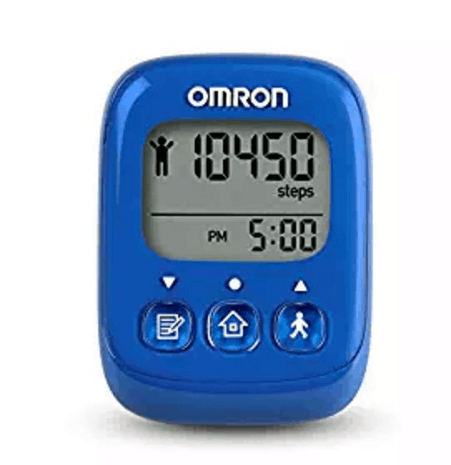
Automatically counts stride length using your height and weight measurements
Auto resets automatically at midnight
Calculates step, distance (miles and kilometers), calories
Uses Tri-Axis technology
Has a memory of 7 days activity
The clock is both 12 and 24-hour format
Battery lasts for one year
Wide display screen and large buttons
Has an inbuilt battery auto saving mode
Recommendation for use: Can be worn on the waist, neck or put in the pocket.
Price/Value
This product is well-priced and affordable considering that you can use it for your aerobics too.
Verdict
If you want a pedometer that can calculate your aerobics steps, is easy to use, with a large display suitable for all ages and is accurate, then Omron is an excellent pick.
- Easy to use
- Calculates aerobic steps
- Automatically resets at midnight
- Is light
- Seven days memory
- Easy to unintentionally press the reset button
8. 3DFitBud
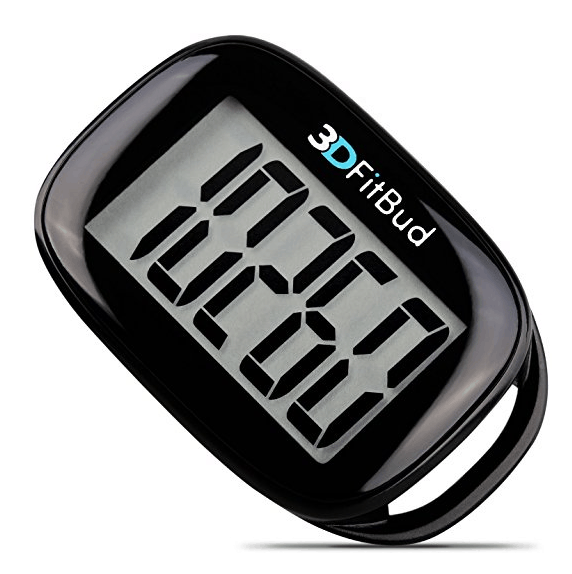
3D Tri-Axis Sensor technology
Extra-large digit display
Battery auto sleeps when you are not moving hence saving battery life
Comes with a downloadable PDF e-book on “Your Guide to Walking for Life.”
Recommendation on usage: can be worn on the neck using a lanyard, put in the pocket or wrist.
Price/Value
3DFitBud is fairly priced considering it is a step-only pedometer that uses 3D sensor technology and is easy to use.
Verdict
It also comes with a complete guide on how you can optimize on walking to improve your fitness level. It is suitable for all ages as it is easy to use and has a large screen display.
Very simple to use
Uses 3D sensor technology
Long battery life
Has an extra-large screen display
Counts steps only
9. Fitness Tracker by Bereezy
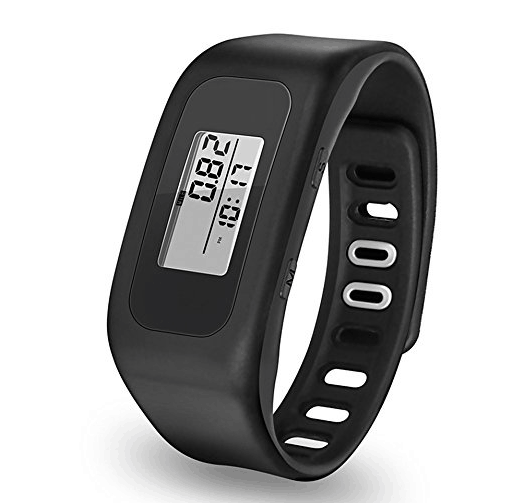
Tracks steps made, distance covered, and calories burned
Small in size
Time Display: Real time in the 12-hour system
Battery life of one year
Recommendation for usage: Wear on the left wrist with words displayed facing the wrist and the buttons on the side of your thumb.
Price/Value
Considering the features that the product offers, it is affordable and a good buy if you need a simple pedometer.
Verdict
This product is a brilliant choice if you want a simple gadget to monitor your walks. It is easy to use, light and has a real-time timer.
- Has a real-time timer
- Light and small
- Battery life of more than a year
- Has a small screen
- Only uses the 12-hour clock format
10. Ozeri 4x3motion
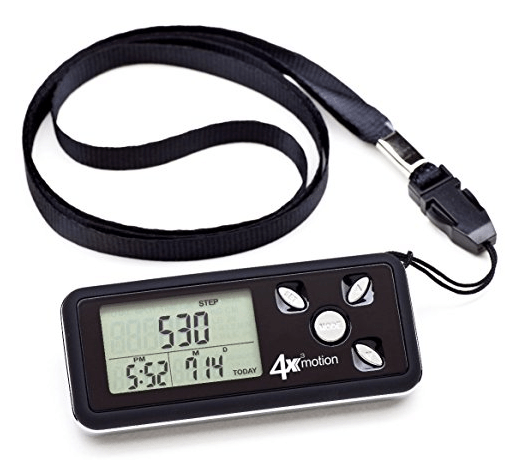
Uses 3D Tri-Axis Technology
Has three recording modes that display daily and total results
Counts up to one million steps
Has a blue backlight suitable for night use
Large screen display
Recommendation for use: You can wear it on the waist or put it in the pocket.
Price/Value
This product is affordable and very fairly priced considering that it uses a 3D sensor, is suitable for night use and makes up to one million step counts.
Verdict
Ozeri is a good choice if you train at night or for long distances. Also, it has a large screen display and easy to use hence suitable for all ages.
- Suitable for night use
- Can make 1millon step counts
- Large screen display
- A bit bulky
Benefits of a Pedometer
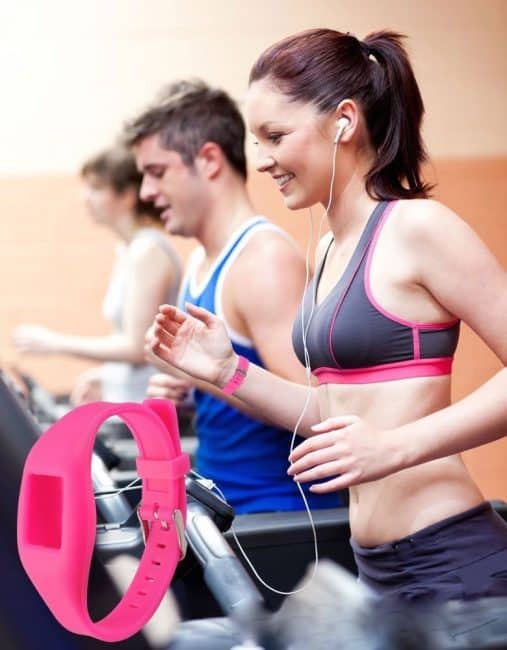
It is undisputable that leading an active life is crucial for overall well-being. Physical activity boosts your energy, mood, sleep, combats diseases, and is excellent for your heart. The American Heart Association (AHA) recommends 150 minutes of moderate intensity exercise in a week, for overall cardiovascular health. Walking, jogging, or running are the simplest forms aerobic activities that you can embark on to meeting this recommendation by the AHA. You do not need to pay gym subscriptions or buy expensive machines; all you need is a good pair of shoes, a suitable outfit, and a pedometer.
The American Council of Exercise recommends that you make ten thousand steps in a day. The best way to tell whether you are meeting this goal is to count your steps; it is not practical to manually count your steps all day long. Thus, a pedometer comes in handy as you can wear it all day long and at the end of the day it will tell you how many steps you have made.
A pedometer also challenges you to meet the goal of ten thousand steps daily and beyond. You can also use a pedometer to track your goals by comparing results at the end of every day, week or month. If you meet your goals, you can proceed to set the goal post higher.
There are also pedometers that enable you to connect with other users for group goal setting and sharing achievements and motivation. If you like sharing your achievements, then this pedometer will motivate you to walk more and faster, and then show off your achievements to the world- we all like a pat on our backs when we do something good, don’t we?
Finally, if a pedometer is correctly used, then it can turn out to be your best walking buddy. It is reliable, affordable, easy to use, and a convenient way to track your physical activity.
Types of pedometers
Pedometers that you will find in the market currently are classified depending on how they work, the output they give and where to wear them.
Classification based on mechanism of action
- Spring-levered pedometers use a spring-suspended horizontal lever that moves in response to hip movement, to open or close an electric circuit then record a step. A spring-levered pedometer has to be placed vertically and perpendicular to the ground for it to be accurate. This pedometer is affected by positioning and will have a high margin error if placed on a horizontal plane to the ground. Hence, if you have a large waist circumference, it may be hard to keep the pedometer in the right position, giving you an error margin of 20 to 60%. This is the mechanism used in pedometers that can only be worn on the waist.
- Piezoelectric Pedometers /Accelerometer pedometers use a piezoelectric mechanism that counts a step when subjected to any movement (acceleration). This is the mechanism used for pocket, wrist or shoe pedometers. Scientific studies have shown that piezoelectric pedometers are more sensitive to slow speed. Hence, if you like walking slowly, a piezoelectric pedometer will be suitable for you. Also, if you have a large waist circumference, you may consider a piezoelectric pedometer since it is not affected by position.
Classification based on output
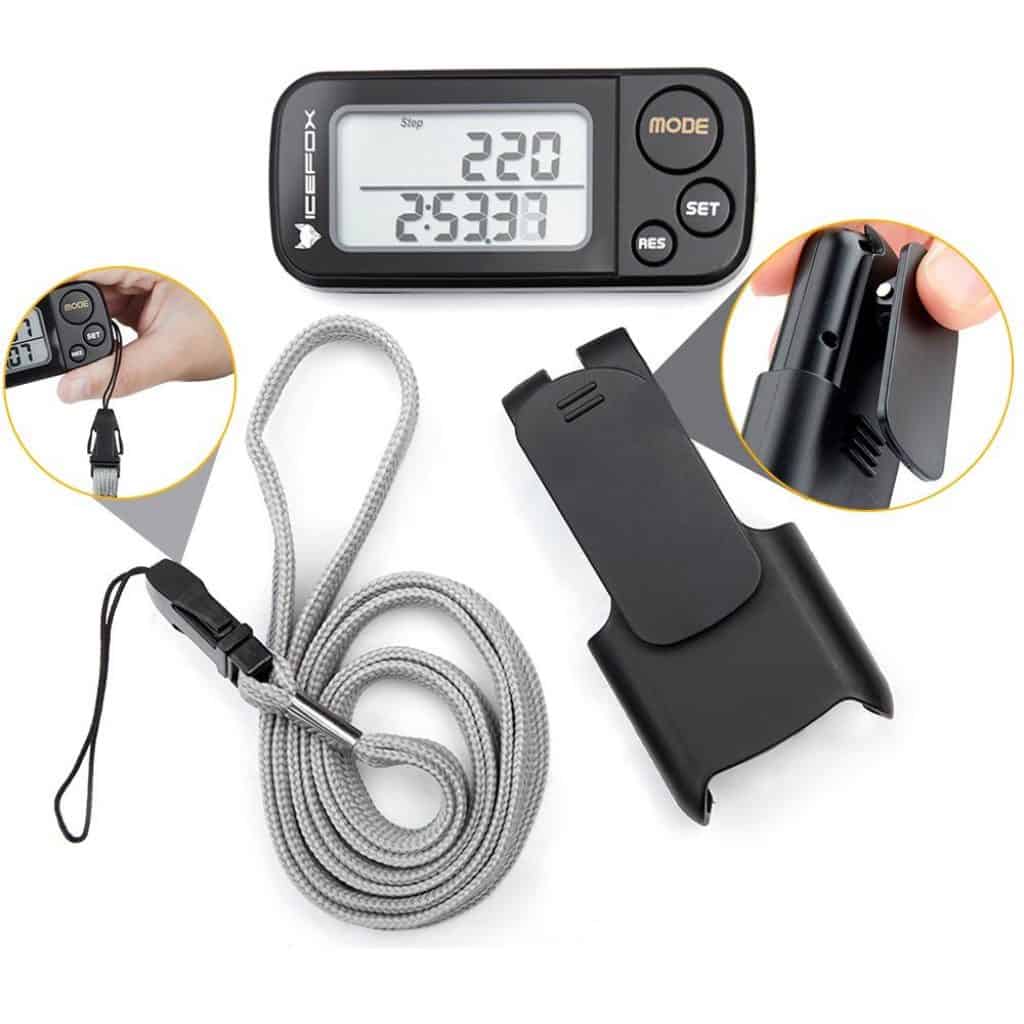
- Step counters only calculate the you steps you make
- Multifunction pedometers calculate steps, distance covered and calories burned
Classification on where to wear
- Waist-clip pedometer – should be clipped on the waist
- Watch pedometer – is worn on the wrist
- Pocket pedometers – you can put it in your pocket or purse
Usage
To track your daily steps, we recommend that you wear your pedometer from when you wake up to when you retire to bed. At the end of the day, record your steps and review them daily, weekly or monthly. Set targets that aim to achieve the recommended ten thousand steps daily or more.
Also, some pedometers come with applications that are synchronized with your phone hence do the tracking for you. We recommend that you put the applications into good use for motivation and accountability purposes.
To get accurate results, we advise that you put on your pedometer in the right place as recommended by the manufacturer. For a waist pedometer, hook the pedometer on your waist just below your armpit and in line with your knee, to get an accurate alignment with the pelvic bone. Waist pedometers that use the spring-levered mechanism if not correctly positioned or put in the pocket or neck can give an error margin of 20 to 60%. Scientific studies have shown that using a pedometer while correctly positioned on the waist gives more accurate results as compared to when it is worn on the neck or put in the pocket. A study published in the Journal of Science and Medicine in Sport showed that pedometers put in the pocket or neck are the least accurate.
For an adjustable pedometer, you can calibrate it to fit your stride length by either entering your weight and height or your foot size.
We also advise that you use your pedometer in the same position and side of the body every day, for you to get consistent results.
How to assess the accuracy of your pedometer
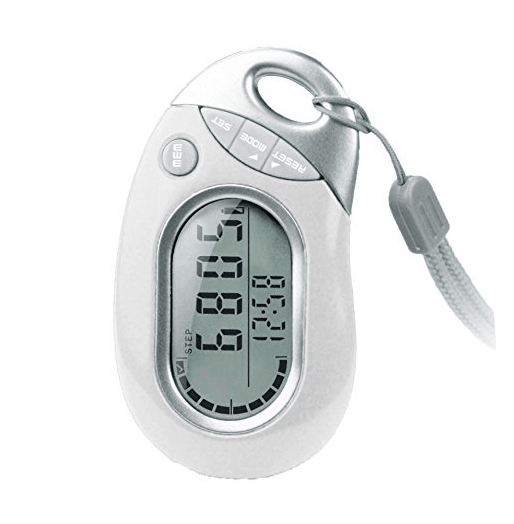
To evaluate how accurate your pedometer is, put on the pedometer then make a hundred steps as you count. Then compare your findings with the results of your pedometer.
An acceptable margin error is that which is not more than 10%. Hence, if your pedometer counted less than 90 or more than 110 steps, then it is not reliable.
Considerations
When purchasing a pedometer, do not only consider its cost but also, if it suits your needs. A study published in the International Journal of Exercise Science proved that the accuracy of a pedometer is not only dependent on its cost. Hence, when choosing a pedometer, we strongly recommend that you carefully study the features of each product, its accuracy, durability, and consistency.
For instance, if you are a long distance trainer, get a pedometer like Ozeri which counts about one million steps (this is way more than the average number of steps that most pedometers count). Also, if you want a pedometer that calculates your steps, monitors sleep, heart rate and also synchronizes with your phone, get an advanced one like Fitbit Zip, Coffea or Lintelek. On the other hand, if you need a simple pedometer that only counts steps, why go for an expensive one that is so complicated to use and needs to be combined with so many other accessories?
Therefore, the best pedometer is the one that meets your needs, is accurate, reliable and within your budget.
Criteria for Selection
You may have purchased several pedometers in the past, but they only end up to be a disappointment each time. Well, we do not blame you: there are hundreds of pedometer brands in the market, and it is quite a task to know which one works and which one does not. We have put in a lot of effort to review pedometers and bring you the best ten that will most certainly meet your goals. This is the criteria that we used to select the products:
Scientific evidence
We have gone through reliable scientific studies that have been carried out to show proof of reliability and accuracy of the pedometers that we currently have in the market. Studies have shown that pedometers may not always be 100% accurate, but their benefits surpass their margin errors.
We chose products that have been subjected to scientific tests and proved to be effective and efficient.
Self-testing
We have used the pedometers that we have listed and proved that they are reliable, consistent and efficient.
User Ratings and Reviews
We went through reviews and ratings of people who have been using pedometers and found out what works best and what does not. We also sampled their complaints and compiled the pros and cons of each product. Therefore, when choosing a product, you will be clear on what to expect.
Output given
We reviewed pedometers that not only count steps but have multiple functionalities. Hence, if you need a simple or advanced pedometer, you will find it on our list.
FAQs
What is it?
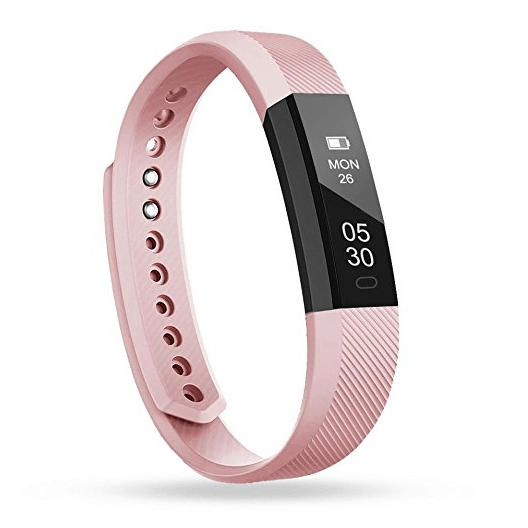
A pedometer is an electronic and portable device that counts the number of steps you make by detecting movement on your hips. Other advanced pedometers can also detect movement in several other parts of your body or while in your pocket.
How does a pedometer work?
A pedometer works by detecting motion by the tilting of the pelvis or movement of your arms each time you make a step.
Other advanced pedometers measure the actual number of times that you stamp on the ground. They are won on the shoes and transmit the data to a wireless device or iPhone. This type is more accurate but more expensive as compared to other pedometers.
Where should I wear it?
There are different types of pedometers that can be worn on your waist, leg, neck, wrist or put in the pocket.
How many steps should I make per day?
The American Council of Exercise recommends that you should make an average of 10, 000 steps per day. This level of physical activity minimizes risk of obesity, cardiovascular diseases, and chronic illnesses.
How many steps make one mile?
The number of strides that you make in a mile depends on your stride length and your pace. Also, the numbers of steps differ when you are walking, jogging or running.
How do I convert miles to kilometers?
There are 1.6 kilometers in a mile. Hence, to convert miles to kilometers, multiply the miles that you have covered with 1.6. For instance, if your pedometer says that you have covered 3 miles, multiply three by 1.6 which equals to 4.8 kilometers.
How accurate are pedometers?
Pedometers are not always 100% accurate. However, studies have shown their benefit surpasses the small margin errors. To improve the accuracy of your pedometer, put it in the right position as instructed by the manufacturer. Also, wear it in the same position and side of the body, for it to give consistent results.
Which is the most accurate one?
The most accurate pedometer is one with a margin error of not more than 10%.
How can I measure the accuracy of my pedometer?
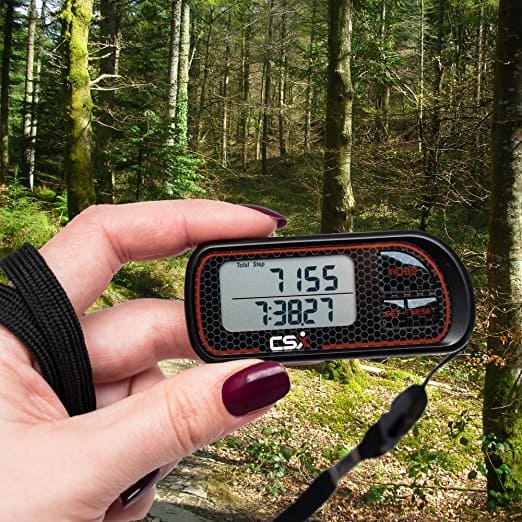
Put on your pedometer then make one hundred brisk steps as you count then compare your number with the pedometer’s results. An error margin of about 10% is acceptable. Anything above that is not reliable.
What is better, a pedometer that overestimates or one that underestimates?
From a health point of view, a pedometer that underestimates is far much better than the one that overestimates. A pedometer that underestimates your steps will make you work more to reach your step goal while one that overestimates will most likely not challenge you enough.
What can contribute to the inaccuracy of a pedometer?
 Wearing a pedometer incorrectly is the most common contributing factor to inaccuracy of pedometers. If a pedometer is only meant for the waist, do not put it in your pocket or wrist. Another factor is if you have not adjusted your stride length for adjustable pedometers.
Wearing a pedometer incorrectly is the most common contributing factor to inaccuracy of pedometers. If a pedometer is only meant for the waist, do not put it in your pocket or wrist. Another factor is if you have not adjusted your stride length for adjustable pedometers.
When should I put on a pedometer?
We recommend that you put on your pedometer when you wake up throughout the day till bed time to get an accurate daily step count.
Which type of pedometer is best for me?
The best type of pedometer for you is dependent on your size, goals, and speed. If you have a very large waist circumference or you like walking slowly, a piezoelectric pedometer will be more accurate for you. If you want a basic pedometer that only counts steps, then a digital step counter will be good for you. If you want one that counts steps, distance, calories, heart rate and sleep duration, get an advanced pedometer like Fitbit Zip or Coffea or Lintelek.
Where can I buy one?
You can buy a pedometer from a sports shop outlet, drug store or online. However, it is the internet that is most convenient. Sites like Amazon give you an opportunity to view various products, compare prices and review users’ feedback and rates. You will most probably make the best-informed decision by purchasing online.






